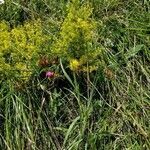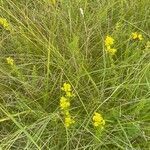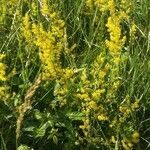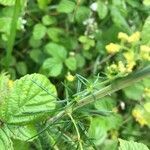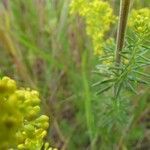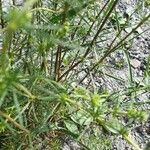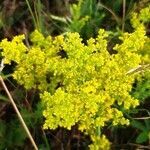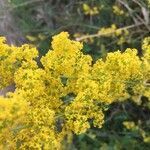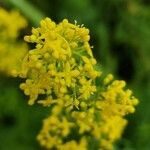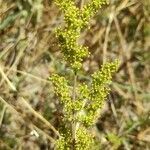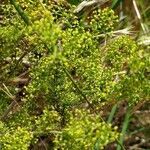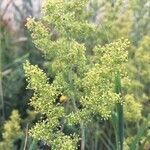Stoloniferous perennial; stems decumbent to erect, often ± tufted, weak, to c. 75 cm long, densely puberulent except towards base; main stems terete or bluntly-angled; branches 4-angled. Lvs and stipules (5)-6-9 per whorl, sessile, 5-20 × c. 1-2 mm, linear or linear-oblong but usually revolute and appearing subulate, ± scabridulous above and on midrib below; margins ciliate; apex sharply acute to shortly awned. Infl. a dense panicle of terminal and axillary cymes, with main axis to > 15 cm long and usually densely puberulent; peduncles often glabrous; pedicels usually < 1.5 mm long at anthesis, glabrous, not divaricating at fruiting, ± = peduncles and sometimes subtended by leaflike bracts; fls very numerous. Corolla 2-3 mm diam., yellow; lobes ovate, with incurved mucro. Mericarps c. 1 mm diam., globose, glabrous, rugulose.
Perennial; stems clustered, 4–10 dm, roundly 4-angled, usually finely puberulent; lvs in whorls of 8–12, ± linear, 1-nerved, 1.5–4 cm × 0.5–3 mm, acute, shining and usually hairy above, densely puberulent beneath, the margins usually ± inrolled; fls bright yellow, forming a dense, showy cymose panicle; 2n=22, 44. Native of Eurasia, now a weed of roadsides and fields in our range, especially northward. June–Sept. (A strictly diploid phase with odorless, lemon-yellow fls and open ± interrupted infl, has been called G. wirtgenii F. W. Schultz (G. verum ssp. wirtgenii), in contrast to typical G. verum, diploid or tetraploid, with fragrant golden-yellow fls and denser infl. We have both.)
A herb or small plant. It grows 0.9-1.2 m tall and spreads 0.9 m wide. It keeps growing from year to year and forms clumps. The stems are square and can become woody near the base. The leaves are small and narrow. They are 30 mm long. They occur in rings of 6 to 8 and have rough edges. These are rolled under and have bristles at the tips. The flowers occur in dense spikes. They are star shaped and yellow.
